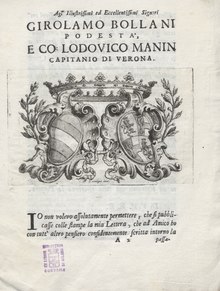Giovanni Battista Martini
Giovanni Battista Martini or Giambattista Martini , called Padre Martini OFMConv (born April 24, 1706 in Bologna , † August 3, 1784 ibid) was an Italian composer and music theorist .
Life
Giovanni Battista Martini received his first music lessons from his father Antonio Maria Martini, a violinist and cellist. Further teachers were Padre Pradieri ( harpsichord ), Giovanni Antonio Riccieri (1679–1746, counterpoint ), Giacomo Antonio Perti (composition), Angelo Predieri (1655–1731) and Francesco Antonio Pistocchi .
In 1722 he entered the Order of the Minorites . He traveled extensively for his training and then devoted himself exclusively to music. In 1725 he became Kapellmeister of the Franciscan Church in Bologna, where he attracted attention with his compositions. He founded a music school, the Liceo Musicale di Bologna , which after his death was continued by his pupil Stanislao Mattei until the 19th century and trained many well-known artists in Italy and abroad.
As a teacher he preferred the old Roman tradition of composition. He was an important pedagogue and music theorist who owned a library of around 15,000 volumes and was considered the highest authority on musical issues, which is why his advice was consulted on many issues. Johann Christian Bach and Florian Leopold Gassmann were among his students. In the winter of 1770, the young Wolfgang Amadeus Mozart was instructed in counterpoint by Martini on his first trip to Italy. Other composers also sought Martini's advice, e. B. Giovanni Battista Cirri , Vicente Martín y Soler , Christoph Willibald Gluck , Niccolò Jommelli , André Grétry and Antonio Boroni . Martini wrote important textbooks on music and was in correspondence with the most famous musicians and scholars from all over Europe.
Works
In addition to 32 masses and a requiem, Padre Martini mainly composed ecclesiastical compositions, most of which remained unpublished, and the “Liceo” in Bologna has several manuscripts. Two oratorios, the Litaniae atque antiphonae finales BV Mariae from 1734 and numerous cantatas and arias. He composed a total of 94 sonatas for keyboard instruments, including the twelve sonatas d'intavolatura , six sonatas for harpsichord and duetti da camera (sonatas for flute and figured bass), plus 24 symphonias, including the Sinfonia con violoncello e violino obbligati and several concerts for solo instruments and strings. Martini composed five works for the stage, including L'impresario delle Canarie (1744).
His most significant legacy is the theoretical works:
- Storia della musica , 3 vols. Bologna, 1757–1781 (large-scale, yet unfinished history of music)
- Saggio fondamentale pratico di contrapunto sopra il canto fermo , 2 vols. Bologna, 1774–1775 (theory of composition)
- Compendio della teoria de 'numeri per uso del musico. Bologna 1769
He preserved his skills as a composer in his textbook Saggio fondamentale pratico di contrapunto , which as a music historian in his famous Storia della musica , which, although unfinished and lacking a systematic arrangement, served as the starting point for many later music-historical works.
literature
- Anselm Pauchard: An Italian Music Theorist. Father Giambattista Martini, Franciscan Conventual (1706–1784). A literary source investigation on the “Storia della musica”. Mazzuconi, Lugano 1941 (Freiburg (Switzerland), Philos. F., Diss.).
- Bernward Wiechens: The Composition Theory and the Church Music Creation of Padre Martini (= Cologne Contributions to Music Research 48, ZDB -ID 503564-8 ). Bosse, Regensburg 1968 (Cologne, Univ., Dissertation from July 19, 1968).
Web links
- Literature by and about Giovanni Battista Martini in the catalog of the German National Library
- Works by and about Giovanni Battista Martini in the German Digital Library
- Sheet music and audio files by Giovanni Battista Martini in the International Music Score Library Project
- Edited letters from and to Giovanni Battista Martini in the web service correspSearch of the BBAW
- Digitized works by Martini - SICD of the Universities of Strasbourg
Individual evidence
- ↑ Erich Steinhard : An old German-Bohemian sound artist. In: German work. Monthly for the intellectual life of Germans in Bohemia. Vol. 7, H. 12, September 1908, ZDB -ID 2860300-X , pp. 745-750, ( online ).
| personal data | |
|---|---|
| SURNAME | Martini, Giovanni Battista |
| ALTERNATIVE NAMES | Martini, Giambattista |
| BRIEF DESCRIPTION | Italian composer and music theorist |
| DATE OF BIRTH | April 24, 1706 |
| PLACE OF BIRTH | Bologna |
| DATE OF DEATH | August 3, 1784 |
| Place of death | Bologna |

